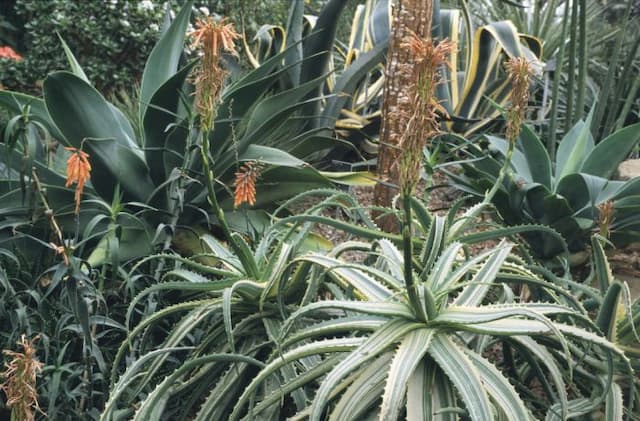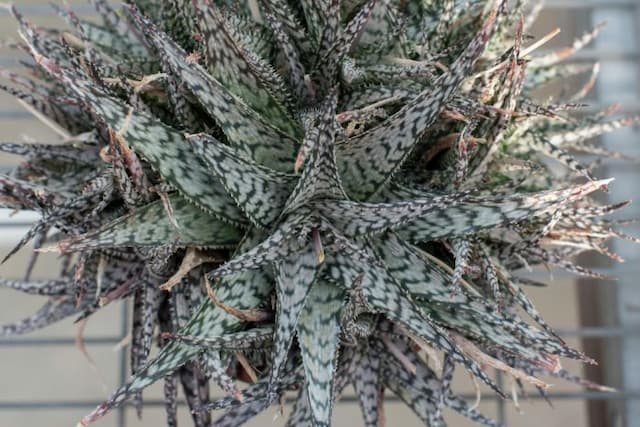Bitter aloe Aloe ferox






ABOUT
The Aloe ferox, commonly known as the Cape Aloe or Bitter Aloe, is a sturdy and succulent plant that boasts a bold and rugged appearance. It has a rosette of dense, fleshy leaves that are a rich green color. Each leaf is generously dotted with thorny spines along the margins and occasionally on the leaf surfaces, giving the plant a somewhat fierce and protective look. The leaves have a thick, waxy texture and may have a reddish tinge when the plant grows in full sun or during dry periods. Cape Aloe produces a striking, tall flower spike that carries tubular flowers, which can be brilliantly colored in shades of red, orange, or yellow. These blossoms stand bold and upright, attracting a variety of birds and insects, particularly during the blooming season. The plant has a central core from which the leaves radiate outward in a balanced and symmetrical pattern. With its resilient leaves and imposing flower spikes, the Aloe ferox makes a distinctive statement in any setting where it is grown, exuding an air of the exotic and wild essence of its native habitat.
About this plant
 Names
NamesFamily
Asphodelaceae.
Synonyms
Cape Aloe, Bitter Aloe, Red Aloe, Tap Aloe.
Common names
Aloe ferox Mill., Aloe perfoliata var. ferox (Mill.) Aiton, Aloe supralaevis Haw., Pachidendron ferox (Mill.) Haw.
 Toxicity
ToxicityTo humans
Cape Aloe, also known as Aloe ferox, contains compounds such as anthraquinones that are known to have a laxative effect. If ingested, it can cause diarrhea and abdominal cramps. The severity of the symptoms can vary depending on the quantity of the plant ingested. Ingestion of large amounts could potentially lead to dehydration, electrolyte imbalance, and gastrointestinal irritation. It is advisable to handle the plant with care as the latex can also cause skin irritation in some individuals.
To pets
Cape Aloe has the potential to be toxic to pets if ingested. Similar to its effects on humans, the anthraquinones present in Aloe ferox can cause gastrointestinal upset in pets, including vomiting, diarrhea, and abdominal pain. The severity of these symptoms can be dependent on the size of the pet and the amount of the plant ingested. It is important for pet owners to prevent their pets from ingesting this plant to avoid potential poisoning.
 Characteristics
CharacteristicsLife cycle
Perennials
Foliage type
Evergreen
Color of leaves
Green
Flower color
Orange
Height
6-9 feet (1.8-2.7 meters)
Spread
3-5 feet (0.9-1.5 meters)
Plant type
Succulent
Hardiness zones
9
Native area
South Africa
Benefits
 General Benefits
General Benefits- Hydration - Aloe ferox gel contains a high water content, which helps in hydrating the skin when applied topically.
- Skin Nourishment - Rich in vitamins and minerals, it nourishes the skin by providing essential nutrients.
- Soothing Effect - The cooling properties of Aloe ferox help in soothing skin from sunburns and minor irritations.
- Moisturizing - It acts as a natural moisturizer without leaving a greasy film on the skin surface.
- Exfoliation - The natural enzymes present in Aloe ferox help in gentle exfoliation, removing dead skin cells.
- Beauty Enhancements - Often used in cosmetic products, it can help improve skin elasticity and overall complexion.
- Gardening - Aloe ferox can be grown as an ornamental plant, adding beauty to gardens and homes.
- Drought Resistance - Being a succulent, it's suitable for xeriscaping and requires minimal watering, ideal for dry climates.
- Erosion Control - Its root system can help prevent soil erosion in arid regions.
- Wildlife Support - Aloe ferox flowers can attract bees and birds, supporting local biodiversity.
 Medical Properties
Medical Properties- Laxative: Aloe ferox contains compounds known as anthraquinones which have a laxative effect and may be used to relieve constipation.
- Skincare: Its gel is traditionally used to soothe skin irritations, burns, and wounds due to its cooling and reparative properties.
- Immune support: Some believe that Aloe ferox can help support the immune system, though scientific evidence is limited.
- Antioxidant: It may provide antioxidant benefits, as it contains various compounds like aloesin that can help protect cells from oxidative stress.
- Anti-inflammatory: The plant's constituents are thought to provide anti-inflammatory effects that may benefit inflammatory conditions.
- Antimicrobial: It has been suggested to possess antibacterial, antiviral, and antifungal properties, which could help in treating infections.
- Digestive health: Aloe ferox is sometimes used to promote digestive health due to its prebiotic effects and influence on gut bacteria balance.
 Air-purifying Qualities
Air-purifying QualitiesThis plant is not specifically known for air purifying qualities.
 Other Uses
Other Uses- Aloe ferox sap can be used as a natural adhesive due to its sticky texture, making it a biodegradable alternative to synthetic glues.
- The dried sap, known as 'Aloe lump,' could be used as a natural ingredient in incense for its aromatic properties.
- It serves as a source of moisture for birds and insects in its natural habitat, which may utilize the liquid from broken leaves.
- The thick leaves can be used as insulation material in small-scale, sustainable building projects.
- When combined with other fibers, Aloe ferox leaves may be processed into a rough textile for crafting or upholstery.
- The striking appearance of Aloe ferox makes it a popular ornamental plant for water-wise landscaping and garden design.
- Aloe ferox's vibrant orange-red flowers can be used in floral arrangements and as a natural dye for fabrics.
- The bitter leaves are sometimes used as a natural pest repellent to protect against herbivorous animals in gardens.
- The plant can be cultivated as a living fence or barrier due to its size and spiky leaves, providing both security and privacy.
- The fibrous leaf material could potentially be used in the manufacturing of eco-friendly paper or packaging products.
Interesting Facts
 Feng Shui
Feng ShuiThe Cape Aloe is not used in Feng Shui practice.
 Zodiac Sign Compitability
Zodiac Sign CompitabilityThe Cape Aloe is not used in astrology practice.
 Plant Symbolism
Plant Symbolism- Healing and Rejuvenation: Aloe ferox is widely known for its medicinal properties, particularly its ability to soothe skin and heal wounds, symbolizing physical and emotional healing.
- Protection: With its thick, spiky leaves, Aloe ferox represents protection and the ability to ward off negative influences or energy.
- Endurance and Resilience: As a plant that thrives in arid conditions, Aloe ferox symbolizes the ability to endure challenging situations and adapt to harsh environments.
- Beauty and Skin Care: Acknowledged for its benefits in skin care products, Aloe ferox comes to symbolize beauty, personal care, and the pursuit of natural enhancement.
- Purification: The plant's cleansing properties are not just physical but also symbolize spiritual purification and the clearing of negative vibrations.
 Water
WaterThe Aloe ferox, commonly known as Cape Aloe, prefers infrequent watering, aligning with a typical succulent's needs. During the summer growing season, water the plant deeply but sparingly, approximately once every two to three weeks, allowing the soil to dry out completely between waterings. Use roughly 8-16 ounces of water depending on the size of the pot. In winter, reduce watering to once a month or less, as the plant enters a dormant period and uses less water. Overwatering can lead to root rot, so it's crucial to ensure the pot has adequate drainage.
 Light
LightCape Aloe thrives in bright light conditions and is best placed in a spot that receives plenty of indirect sunlight, such as a south or west-facing window. Direct sun can be tolerated, especially in cooler climates, but in hotter areas, it may require some shade during the harshest parts of the day to prevent leaf scorching. Adequate light is essential for the plant to maintain its vibrant color and structural integrity.
 Temperature
TemperatureCape Aloe prefers warmer temperatures, ideally between 50 to 85 degrees Fahrenheit, to thrive. It can survive in temperatures as low as 40 degrees Fahrenheit, but prolonged exposure to cold will damage the plant. Avoid placing it in areas with cold drafts or temperatures that drop significantly at night. Its ideal growth conditions are in warm, stable temperatures within its preferred range.
 Pruning
PruningPruning Cape Aloe is primarily done to remove dead or damaged leaves and to maintain a tidy appearance. Use a clean, sharp knife or scissors to cut away leaves close to the base. Pruning is best done in the spring or early summer when the plant is actively growing. It's typically infrequent, only when necessary, and always with a mind to avoid damage to the healthy rosette.
 Cleaning
CleaningAs needed
 Soil
SoilCape Aloe requires a well-draining cactus or succulent potting mix with added perlite or coarse sand for extra drainage. The best soil pH for Cape Aloe is between 6.0 and 7.5.
 Repotting
RepottingCape Aloe should be repotted every two to three years or when it outgrows its container to provide fresh soil and more space for growth.
 Humidity & Misting
Humidity & MistingCape Aloe prefers low to moderate humidity levels and thrives in the typical dry air found in most homes.
 Suitable locations
Suitable locationsIndoor
Place Cape Aloe in bright light, away from drafts, with minimal watering.
Outdoor
Plant Cape Aloe in full sun, protect from frost, and provide well-draining soil.
Hardiness zone
9-11 USDA
 Life cycle
Life cycleThe life cycle of Aloe ferox, commonly known as the Bitter Aloe, begins with seed germination, initiated by adequate warmth and moisture. Once emerged, the seedlings grow slowly, developing fleshy, spiky leaves characteristic of mature plants. Bitter Aloe may take four to five years to reach maturity, at which point it can produce its first inflorescence — a tall, striking flower spike. The plant blooms mostly in winter, with the flowers attracting birds and insects that facilitate pollination. After pollination, seed pods form and eventually dry, releasing seeds to begin the cycle anew. This perennial can live many years, with older plants often developing a single, woody stem and continuing to produce new leaves and flower spikes annually.
 Propogation
PropogationPropogation time
Spring-early summer
The Cape Aloe, commonly referred to as Aloe ferox, is usually propagated through seed or by removing and replanting the offsets, also known as pups, that it produces at its base. The most popular method for propagating Cape Aloe is by using these offsets. Pups should be removed from the parent plant during the warmer months when the plant is actively growing, typically in late spring or early summer. To propagate using offsets, gently detach a pup from the main plant using a clean, sharp knife. Allow the pup to dry and form a callus over the cut surface for a few days to reduce the risk of rot. Once calloused, plant the pup in a well-draining cactus or succulent potting mix, and water it sparingly until it establishes roots. It's crucial not to overwater as this can lead to root rot.









